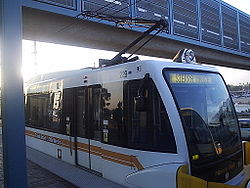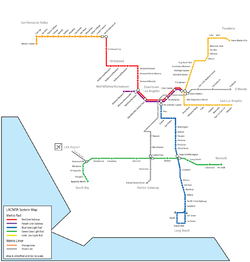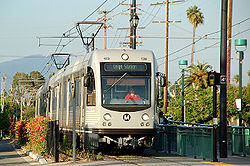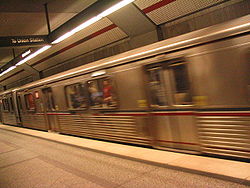- Metro Rail (Los Angeles County)
-
Los Angeles County Metro Rail 
Info Locale Los Angeles County, California Transit type Rapid transit (heavy rail and light rail) Number of lines 5 Number of stations 70 (23 under construction) Daily ridership 349,432 (July 2011)[1] Operation Began operation 1990 Operator(s) Los Angeles County Metropolitan Transportation Authority (LACMTA) Technical Track gauge 4 ft 8 1⁄2 in (1,435 mm) (standard gauge) System map Metro Rail is the rapid transit rail system consisting of five separate lines (the red, purple, blue, green, and gold lines) serving 70 stations in the Los Angeles County, California area. The new Expo line is due to enter service in early 2012. It connects with the Metro liner bus rapid transit system (the orange line and silver line) and also with the Metrolink commuter rail systems. The system, which has a daily weekday ridership of approximately 350,000 as of July 2011[update],[1] is owned and operated by the Los Angeles County Metropolitan Transportation Authority (Metro) and started service in 1990. It has been extended significantly since that time and several further extensions are either in the works or being considered.
It is the indirect descendant of the Pacific Electric Red Car and Los Angeles Railway Yellow Car lines, which operated between the late 19th century and the 1960s.[2]
Contents
Current system
 A Gold Line train in Pasadena, the line's current northeast terminus.
A Gold Line train in Pasadena, the line's current northeast terminus.
Lines
In Los Angeles Metro terminology, a line is a named service, defined by a route and set of stations served by trains on that route. (The word does not refer to a physical rail corridor, as it does in New York City Subway nomenclature.) Metro Rail lines are currently named after colors, and these colors are used to distinguish the lines on Metro's maps. However, Metro also uses colors for its Metro Liner services (which are actually bus services operating in transitways). And some future Metro Rail lines (in particular, the Expo and Crenshaw Lines) have no colors assigned to them yet.
Five Metro Rail lines currently operate in Los Angeles County:[1]
 The Metro Red Line is a heavy rail subway line that connects Downtown Los Angeles to North Hollywood, passing through several neighborhoods in Hollywood and Mid-Wilshire.
The Metro Red Line is a heavy rail subway line that connects Downtown Los Angeles to North Hollywood, passing through several neighborhoods in Hollywood and Mid-Wilshire.
 The Metro Purple Line is a heavy rail subway line running between Downtown Los Angeles and Koreatown/Mid-Wilshire.
The Metro Purple Line is a heavy rail subway line running between Downtown Los Angeles and Koreatown/Mid-Wilshire.
 The Metro Blue Line is a light rail line running between Downtown Los Angeles' Financial District and Downtown Long Beach. In between, the line serves several neighborhoods and cities in the county's south-central region, including Huntington Park, South Gate, Willowbrook and Compton.
The Metro Blue Line is a light rail line running between Downtown Los Angeles' Financial District and Downtown Long Beach. In between, the line serves several neighborhoods and cities in the county's south-central region, including Huntington Park, South Gate, Willowbrook and Compton.
 The Metro Green Line is a fully elevated light rail line running between Redondo Beach and Norwalk. In between, the line serves several neighborhoods and cities, including El Segundo, Hawthorne, and Lakewood. It offers indirect access to Los Angeles International Airport via a shuttle bus from the Aviation/LAX station.
The Metro Green Line is a fully elevated light rail line running between Redondo Beach and Norwalk. In between, the line serves several neighborhoods and cities, including El Segundo, Hawthorne, and Lakewood. It offers indirect access to Los Angeles International Airport via a shuttle bus from the Aviation/LAX station.
 The Metro Gold Line is a light rail line that runs between East Los Angeles and Pasadena, passing through Boyle Heights, Little Tokyo, Downtown Los Angeles, Highland Park and South Pasadena.
The Metro Gold Line is a light rail line that runs between East Los Angeles and Pasadena, passing through Boyle Heights, Little Tokyo, Downtown Los Angeles, Highland Park and South Pasadena.
The Red and Purple Lines follow a fully underground route (subway), and the Green Line follows a fully elevated route. The Blue and Gold Line routes run in a mix of environments, including at-grade street running, at-grade ROW, elevated, and underground.[1]
The two heavy-rail lines (Red and Purple) share right-of-way between Union Station and Wilshire/Vermont. Currently, none of the three light-rail lines share right-of-way, although they use compatible technologies. Future system expansions are expected to utilize shared light-rail rights-of-way.
Hours of operation
All Metro Rail lines run regularly between 5am and midnight, seven days a week. Limited service on particular segments is provided after midnight and before 5am. There is no rail service between 2am and 3:30am. Service operates every 5-10 minutes during the peak period, every 10-15 minutes during middays and during the day on weekends, and every 20 minutes during the evening until the close of service. Exact times vary from route to route.
Fares and fare collection
The standard Metro base fare applies for all trips. Transfers between lines are not free: each line requires a separate fare.
The following table shows Metro fares, effective August 1, 2011 (in US dollars):
Fare Type Regular Senior
/Disabled
/MedicareBase Fare $1.50 $.55 Tokens $1.50 Metro Day Pass $5.00 $1.80 Weekly Pass $20.00 Student Fare Card (with monthly stamp) $24.00 College/Vocational (with monthly stamp) $36.00 Monthly Pass $75.00 $14.00 Metro-to-Muni Transfer $.35 $.10 Fare collection is based on a proof of payment system. At least two fare machines are located outside each station. Fare inspectors and deputy sheriffs police the system and cite individuals without fares.
Transit Access Pass (TAP) and fare gates
Metro is moving toward a new system of electronic fare collection using a stored value smartcard called the Transit Access Pass (or TAP Card). This card, similar in technology to London's popular Oyster card, was intended to simplify fare collection and reduce costs.[3] In 2009, paper monthly passes were eliminated, and replaced with the TAP Card.
In addition, Metro began installing ticket barriers (fare gates) in 2008, at all subway stations, select light rail stations and all future stations. It was estimated that Metro lost 5.5 million USD a year because of the honor system method. The barriers are intended to eliminate these losses. In addition, the fare gates are intended to improve security at all the stations, provide better ridership statistics and create the ability to have zone fares.
Implementation of both programs (the TAP program and the fare gate program) has turned out to be expensive ($154 million in total, so far) and problematic.[4]
Ridership
As of September 2010, the combined Metro Red and Purple lines averaged a weekday ridership of 148,214,[1] making it the ninth busiest rapid transit system in the United States. Taking overall track length into consideration, Metro Rail's heavy rail lines transport 9,348 passengers per route mile, making this the ninth busiest system per length. This is still far lower ridership than transit systems of New York City, Boston, and Philadelphia, but roughly the same ridership as the Washington Metro, a much larger heavy rail system.
Metro's light rail system is the third busiest LRT system in the United States by ridership, with 160,464 average weekday boardings during September 2010.[1] Additionally, the Blue Line is the second largest light rail line by ridership in the United States with an average weekday ridership of 82,840, after the Boston Green Line's daily ridership of 235,300, though the Boston Green Line has four outbound termini, so that its 25 miles (40 km) of track service a larger lateral area than the Blue Line's 22 miles (35 km), but a shorter length.[5]
Stations
Main article: List of Los Angeles County Metro Rail stationsThe unmanned stations include at least two ticket machines, wayfinding displays, and bench seating. Surface stations are designed with shade canopies. Many suburban stations also have free or reserved parking available and some have bike storage available. Metro Rail stations are not staffed and do not yet have operating fare gates. The majority of stations are either at ground level or elevated, but there is also a significant number of them underground. Each station has a unique design with an interior design reflecting local culture and/or the function of transit in society. Both subway stations and tunnels are designed to resist earthquakes of up to magnitude 7.5.
History
Background
For over five decades, Southern California had one of the most extensive rail transit networks in the world, with over 1,000 miles (1,600 km) of track operated by the Pacific Electric Railway (Red Cars) and Los Angeles Railway (Yellow Cars). The rail system was dismantled piecemeal in the years after World War II by a network of holding companies and intermediaries owned by a General Motors-led consortium as part of an effort to sell more buses and cars in what became known as the Great American streetcar scandal. Streetcar use went into a steep decline, and, by 1963, all Los Angeles streetcar lines were closed down in favor of using automobiles on an extensive freeway system. In the decades that followed, the immense volume of traffic generated by the automobiles of 14 million people in the greater metropolitan area eventually led to renewed support for mass transit.
Planning
Beginning in the 1970s, a variety of factors, including environmental concerns, an increasing population and the price of gasoline led to calls for mass transit other than buses. In 1976, the State of California formed the Los Angeles County Transportation Commission to coordinate the SCRTD's efforts with those of various municipal transit systems in the area and to take over planning of countywide transportation systems. The SCRTD continued planning of the Metrorail Subway (the Red Line), while the LACTC developed plans for the light rail system. After decades, the wheels of government began to move forward, and construction began on the Los Angeles County Metro Rail system in 1985. In 1988, the two agencies formed a third entity under which all rail construction would be consolidated. In 1993, the SCRTD and the LACTC were finally merged into the Los Angeles County Metropolitan Transportation Authority (LACMTA, now known as Metro).
The LACMTA began construction of the initial lines throughout the 1980s using revenues from a voter-approved increase in sales tax.
Operation
The Blue line finally opened on 14 July 1990, some 27 years after the final streetcar line closed, and has since been developed to its current size. The following table shows the timeline of this expansion:
Segment description Date opened Line(s) Endpoints # of new
stationsLength
(miles)Blue Line Initial Segment July 14, 1990 Blue Pico to Anaheim Street 17 19.1 Blue Line Long Beach Loop September 1, 1990 Blue Anaheim Street to Pacific 4 2.2 Blue Line To Financial District February 15, 1991 Blue Pico to 7th St/Metro Center 1 0.7 Red Line MOS-1 January 30, 1993 Red, Purple* Union Station to Westlake/MacArthur Park 4** 4.4 Green Line August 12, 1995 Green Redondo Beach to Norwalk 13** 20.0 Red Line MOS-2 West May 26, 1996 Red, Purple* Westlake/MacArthur Park to Wilshire/Western 3 2.0 Red Line MOS-2 North June 12, 1999 Red Wilshire/Vermont to Hollywood/Vine 5 4.7 Red Line MOS-3 June 24, 2000 Red Hollywood/Vine to North Hollywood 3 6.3 Gold Line To Pasadena July 27, 2003 Gold Union Station to Sierra Madre Villa 12 13.7 Gold Line Eastside Extension November 15, 2009 Gold Union Station to Atlantic 8 6.0 70 79.1 * Segment opened as part of the Red Line corridor. The Purple Line was not defined as a distinct line until 2006.
** Segment also included significant expansion of an existing station: this was not counted as a new station.Future
Metro has worked over the past several years to plan and prioritize project funding and implementation. Metro's 2009 Long Range Transportation Plan (LRTP) was developed to provide a long-term vision of transportation system development for the next 30 years.[6] Measure R, a countywide incrememental sales tax increase passed by voters in 2008, provides funding for many of the highest priority projects in the LRTP.[7]
Current and priority projects
The following rail projects have been given high priority by Metro. They all appear in the LRTP constrained plan,[6] and all have funding earmarked from Measure R (except Expo Phase 1, which had already been funded before the measure passed).[7]
Project Name Description Earliest
Measure R FundsExpected
CompletionStatus
(November 2011)Expo Line Phase 1 Creates the initial light-rail route to be used by the Metro Expo Line, from Downtown Los Angeles to Culver City. n/a Nov. 2011, Mar. 2012 Complete. Pre-Revenue Testing Gold Line Foothill Extension Phase 2a Extends the Metro Gold Line light rail corridor from its current terminus in East Pasadena to the eastern edge of Azusa. 2010-12 2015 under construction Expo Line Phase 2 Extends the Metro Expo Line light rail corridor westward from Culver City to Santa Monica. 2010-12 2015 under construction Crenshaw/LAX Transit Corridor Creates a new light-rail route to be used by the Metro Crenshaw Line, from Crenshaw/Expo (Metro Expo Line) to Aviation/Imperial (Metro Green Line). 2010-12 2016 pre-construction Regional Connector Creates a new light-rail route through Downtown Los Angeles, linking the Metro Blue Line, Gold Line and Expo Line. 2014-16 2019 Final EIR in progress Westside Subway Extension Extends the Metro Purple Line west along Wilshire to Westwood. 2013-15 2022 Final EIR in progress Gold Line Eastside Phase 2 Corridor Extends the Metro Gold Line from its current Eastside terminus eastward. 2022-24 2035 Draft EIR in progress Green Line Extension to South Bay Extends the Metro Green Line from its current terminus in Redondo Beach toward the South Bay. 2028-30 2035 Draft EIR in progress West Santa Ana Branch Corridor Creates a new mass transit route connecting the Gateway Cities to Orange County. 2015-17 2027 alternatives analysis in progress Gold Line Foothill Extension Phase 2b Extends the Metro Gold Line light rail corridor from the Phase 2a terminus in Azusa to Montclair, just past 0.6 miles (0.97 km) of the county line in San Bernardino County. 2013 2019 scoping in progress Green Line Extension to LAX Extends the Metro Green Line northwest to LAX. 2010-12 2028 not started Sepulveda Pass Transit Corridor Creates a new rapid-transit route connecting the west San Fernando Valley to the Westside. 2030-32 2039 not started Other expansion concepts
The following proposed line/system expansions do not currently have funding or high priority in Metro's long-range plans. (More information on each project can be found in the references.)
Concept Name Description Source Pink Line (Originally HRT) Create new LRT connecting Metro Red Line's Hollywood/Highland station to Metro Purple Line, via Santa Monica Boulevard and West Hollywood. Possible future extension south of Wilshire on San Vicente Boulevard, connecting to a future Crenshaw Line that would run north of Exposition Boulevard. Metro's Westside Subway Extension meetings.[15] Gold Line Ontario Extension Further extend Metro Gold Line eastward to L.A./Ontario International Airport, via Upland. Metro Gold Line Foothill Construction Authority,[10] GoldLine2Ontario.com[22] Red Line Eastern Extension Extend Metro Red Line (or Purple Line) from eastern terminus, south along the river to either Arts District or the future "Cleantech" corridor, and possibly across the river along Whittier Blvd. to the Eastside.[23] Red Line To Burbank Airport Extend Metro Red Line from 3.2 miles (5.1 km) northwestern terminus to Burbank Airport. Lincoln Blvd Line Extend Green Line northwest to Westchester, Marina Del Rey or Santa Monica. Green Line To Norwalk Metrolink Extend Green Line east to Norwalk/Santa Fe Springs (Metrolink station). Vermont Corridor Subway Create new subway down Vermont Avenue, connecting Metro Red Line and Purple Line to Metro Expo Line and Green Line. "Silver Line" (former name) New light-rail line planned to connect El Monte to Hollywood, via Valley Blvd corridor and Santa Monica Boulevard. Silver Line website (archived),[24] The Transit Coalition website[25] NoHo-Pasadena Corridor Yellow Line North Hollywood to Downtown L.A. Planned to use former Pacific Electric "Belmont Tunnel." Tunnel can no longer be used due to recent construction now blocking tunnel portal. Harbor Line Light rail line to connect harbor area (San Pedro) to Metro Blue Line or Green Line. Citizens for a Harbor Line (blog)[26] Get LA Moving Detailed comprehensive plan of regional mass transit, including new lines and extensions to existing lines. Get L.A. Moving Plan[27] LAX Express Limited stop line connecting Union Station to Los Angeles International Airport, mainly via rail right-of-way along Slauson Avenue. Operations
Rolling stock
Main article: Los Angeles Metro Rail rolling stockMetro Rail maintains two distinct systems of rail: a light rail system and a heavy rail system. The heavy rail and light rail systems are incompatible with each other, despite the fact that they both utilize standard gauge track (4 ft 8 1⁄2 in (1,435 mm) between rails). Metro's heavy rail lines are powered by third rail, whereas its light rail lines are powered by overhead catenary lines. Also, the widths of the cars are different, and platforms are designed to match the separate car widths.
Security and safety
Metro Rail's trains and stations are patrolled by the Los Angeles County Sheriff's Department,[28] and are monitored by security personnel via closed-circuit television cameras.[29]
See also
- Los Angeles County Metropolitan Transportation Authority
- Los Angeles Metro Rail rolling stock
- Transportation in Los Angeles
- List of rapid transit systems
- List of United States rapid transit systems by ridership
- Measure R
- Breda A-650 Metro Red Line Railcar
References
- ^ a b c d e f "Facts At A Glance". Metro. January 28, 2011. http://www.metro.net/news/pages/facts-glance/. Retrieved January 28, 2010.
- ^ Taplin, Michael (1991). "City of the Automobile: Los Angeles looks to Light Rail London: Platform 5 Publishing/Light Rail Transit Association". Light Rail Review 2. pp. 27–30. ISBN 1-872524-23-0.
- ^ "Fares". Metro.net. http://www.metro.net/around/fares/. Retrieved September 30, 2010.
- ^ "MTA's $46M system of locking turnstiles sits unused, waiting for fare cards to be adopted - LA Daily News". Dailynews.com. August 21, 2010. http://www.dailynews.com/news/ci_15847509. Retrieved September 30, 2010.
- ^ American Public Transportation Association, Light Rail Transit Ridership Report, Second Quarter 2007.
- ^ a b "Plans". Metro.net. http://www.metro.net/projects/reports/. Retrieved September 30, 2010.
- ^ a b "Measure R". Metro.net. http://www.metro.net/projects/measurer/. Retrieved September 30, 2010.
- ^ a b buildexpo.org
- ^ "Metro Rail Expo Corridor, Phase 1 to Culver City". Metro.net. http://www.metro.net/projects/exposition/. Retrieved September 30, 2010.
- ^ a b c Metro Gold Line Foothill Construction Authority. "Metro Gold Line Foothill Construction Authority (project website)". http://www.metrogoldline.org. Retrieved August 21, 2010.
- ^ a b "Gold Line Foothill Extension". Metro.net. http://www.metro.net/projects/foothill-extension/. Retrieved September 30, 2010.
- ^ "Metro Rail Expo Corridor, Phase 2 to Santa Monica". Metro.net. http://www.metro.net/projects/expo-santa-monica/. Retrieved September 30, 2010.
- ^ "Crenshaw/LAX Transit Corridor". Metro.net. http://www.metro.net/projects/crenshaw_corridor/. Retrieved September 30, 2010.
- ^ "Regional Connector Transit Corridor". Metro.net. http://www.metro.net/projects/connector/. Retrieved September 30, 2010.
- ^ a b Metro. "Westside Subway Extension (project website)". http://www.metro.net/projects/westside/. Retrieved August 21, 2010.
- ^ "Eastside Transit Corridor Phase 2". Metro.net. http://www.metro.net/projects/eastside_phase2/. Retrieved September 30, 2010.
- ^ "South Bay Metro Green Line Extension". Metro.net. http://www.metro.net/projects/south-bay/. Retrieved September 30, 2010.
- ^ "West Santa Ana Transit Corridor". Metro.net. http://www.metro.net/projects/west-santa-ana/. Retrieved September 30, 2010.
- ^ "Home". pacificelectriccorridor.com. http://www.pacificelectriccorridor.com. Retrieved September 30, 2010.
- ^ "Green Line LAX Extension". Metro.net. http://www.metro.net/projects/lax-extension/. Retrieved September 30, 2010.
- ^ "Sepulveda Pass Transit Corridor". Metro.net. http://www.metro.net/projects/sfv-405/. Retrieved September 30, 2010.
- ^ "Serv-U from RhinoSoft.com". Goldline2ontario.com. http://www.GoldLine2Ontario.com/. Retrieved September 30, 2010.
- ^ "Los Angeles Downtown News and Information". Ladowntownnews.com. May 27, 2010. http://www.ladowntownnews.com/articles/2010/06/01/news/doc4bfedebed3f7f649310867.txt. Retrieved September 30, 2010.
- ^ http://web.archive.org/web/20051029033755/http://www.metrosilverline.com/
- ^ http://thetransitcoalition.us/
- ^ http://harborline.blogspot.com/
- ^ http://glam.fminus.com/
- ^ "Security". Metro.net. July 23, 2009. http://www.metro.net/around/safety-security/security/. Retrieved September 30, 2010.
- ^ "Pasadena Gold Line FAQ". Ww2.cityofpasadena.net. http://ww2.cityofpasadena.net/trans/TRANSIT/goldline/faq.asp. Retrieved September 30, 2010.
External links
- Official Metro website
- Gold Line Foothill Extension Construction Authority website
- History of the Metro Rail System
- The Transit Coalition
- Network map (to-scale)
- Los Angeles Metro System on Google Maps
- Google map of Metro Rail Stations
Los Angeles County Metropolitan Transportation Authority Metro services Metro RailMetro Bus
Major facilities Capital projects Other information Bus fleet • Rail fleet • Transit Access Pass (TAP) • Transportation in Los AngelesCurrently operating heavy rail rapid transit systems in the United States Massachusetts Bay Transportation Authority (Blue, Orange, and Red Lines) · MTA (New York City Subway and Staten Island Railway) · Port Authority Trans-Hudson · Southeastern Pennsylvania Transportation Authority (Market–Frankford and Broad Street lines) · PATCO Speedline · Baltimore Metro Subway · Washington Metro · Metropolitan Atlanta Rapid Transit Authority · Miami Metrorail · San Juan Tren Urbano · Cleveland Red Line · Chicago 'L' · Bay Area Rapid Transit · Los Angeles Metro Rail (Red and Purple Lines)
Currently operating light rail and streetcar systems in the United States ArkansasArizonaCaliforniaMUNI: Cable Car, F Market & Wharves, and Metro lines · Metro Rail: Blue Line, Green Line and Gold Line · Sacramento RT · San Diego Trolley · Sprinter · Santa Clara VTA · Waterfront Red CarColoradoFloridaGeorgiaRiver Street StreetcarLouisianaMassachusettsMarylandMinnesotaMissouri / IllinoisNew JerseyNew YorkNorth CarolinaOhioOregonPennsylvaniaPittsburgh Light Rail · SEPTA Routes 15, 101, 102, and Subway–Surface LinesTennesseeTexasUtahVirginiaWashingtonLink Light Rail · Seattle Streetcar NetworkWisconsinCategories:- Los Angeles County Metropolitan Transportation Authority
- Los Angeles County Metro Rail
- Passenger rail transportation in California
- Public transportation in Los Angeles County, California
- Railway lines opened in 1990
- Standard gauge railways in the United States
- Transportation in Los Angeles, California
- Underground rapid transit in the United States
Wikimedia Foundation. 2010.



